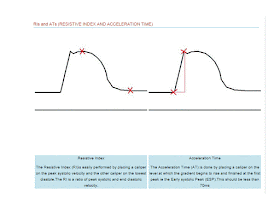ULTRASOUND OF THE RENAL ARTERIES - NORMAL
https://www.ultrasoundpaedia.com/normal-renal-arteries/
There are 2 techniques, direct method and indirect method, used to investigate renal arterial supply. Both ideally are used in conjuction with each other, however, in circumstances where the renal artery is not seen in its entirety then the indirect approach alone can give an indication of vascular disease.
DIRECT ASSESSMENT
ANTERIOR APPROACH
OBLIQUE APPROACH
Oblique Approach Oblique Approach.Angling 45 degrees to right renal artery or rolling the patient in a semi left decubitus position to avoid the bowel gas and improve the Doppler angle.  |
Anterior Approach. The renal arteries are clearly imaged in B Mode from an anterior approach however as it is perpendicular to the ultrasound beam it is not suitable for Doppler assessment. In most individuals, the renal arteries arise from the abdominal aorta immediately distal to the origin of the superior mesenteric artery (SMA). The right renal artery passes underneath the inferior vena cava (IVC) and posterior to the right renal vein. ANTERIOR v's OBLIQUE Oblique Approach.Angling 45 degrees to right renal artery.In most individuals, the renal arteries arise from the abdominal aorta immediately distal to the origin of the SMA. By moving the probe to the right of midline and angling toward the patient's left, an acceptable Doppler angle of 45-60 degrees is achieved. |
| Normal waveform A normal waveform obtained from the main renal artery demonstrates a rapid upstroke in systole and a low resistance waveform with continuous forward flow throughout the cardiac cycle. The normal peak systolic velocity of the main renal artery is less than 150 cm/sec. The resistive index is less than 0.70 .Doppler sampling throughout the entire artery from the origin to the hilum. |
Coronal Approach
Roll the patient into a decubitus position to avoid bowel gas and improve visibility of the renal artery,especially the mid to distal portion.
INDIRECT METHOD
An indirect assessment requires a good colour image to determine the position of the interlobar and interlobular arteries, which in turn will determine the best angle to get an accurate measurement of the RI and AT.
 |
RIs and ATs (RESISTIVE INDEX AND ACCELERATION TIME)
Resistive Index The Resistive Index (RI) is easily performed by placing a caliper on the peak systolic velocity and the other caliper on the lowest diastole.The RI is a ratio of peak systolic and end diastolic velocity. Acceleration Time The Acceleration Time (AT) is done by placing a caliper on the level at which the gradient begins to rise and finished at the first peak ie the Early systolic Peak (ESP).This should be less than 70ms
Renal
Artery Stenosis
Maria R. Bokhari; Syed Rizwan A. Bokhari.
Renal artery stenosis is narrowing of the one or both of
renal arteries. It is the major cause of hypertension and according to
some reports is the cause of hypertension in 1% to 10% of the 50 million people
in the United States. Atherosclerosis or fibromuscular dysplasia most often
cause it. Other associated complications of renal artery stenosis are
chronic kidney disease and end-stage renal disease.
|
Duplex ultrasonographic scanning is a noninvasive, relatively
inexpensive technique that can be used in patients with any level of renal
function. However, it is operator dependent and has variable
sensitivity. Two approaches are used to detect RAS with Doppler Ultrasound.
- Direct Visualization of the
Renal Arteries: The first approach involves direct scanning of the main
renal arteries with color or power Doppler US followed by spectral
analysis of renal artery flow using an anterior or anterolateral approach.
Owing to various factors essentially as gas interposition and the anatomy
of the left renal artery, a complete examination of both renal arteries
can be achieved in only 50%–90% of cases. Signal enhancement can be
achieved by administering contrast agents that facilitate visualization of
the renal arteries. Four criteria are currently used to diagnose
significant proximal stenosis:
1. An increase in peak systolic velocity in the
renal artery (the post-stenotic threshold for significant RAS is
100 cm/sec to 200 cm/sec is reported)
2. A renal-to-aortic peak systolic velocity ratio
of greater than 3.5
3. Turbulent post-stenotic site
4. Visualization of the renal artery without any
detectable Doppler signal, an observation that signals occlusion.
- Analysis of Intra-renal Doppler
Waveforms: The different segments of
kidneys are scanned via trans lumbar approach systematically to detect a
stenosis of a segmental or accessory renal artery. Quantitative criteria
proposed for detection of significant RAS:
1. Acceleration of less than 370 cm/sec
to 470 cm/sec. The early systolic acceleration seems to be the best
predictor of renal artery narrowing
2. Acceleration time greater than 0.05 sec to 0.08
sec
3. Change in the resistive index (RI) of
greater than 5% between the right and left kidneys. This value should be
measured along the initial portion of the systolic rise and avoid including the
late compliance peak
4. A dampened presentation (pulsus tardus) of an
intrarenal Doppler waveform indicates stenosis
5. The presence of an early systolic peak can be
interpreted as a sign of normality; however, the absence of an early systolic
peak is not necessarily indicative of stenosis.
Chronic kidney disease
Ultrasound with Doppler examination of intrarenal vessels is usually performed in patients with CKD, and it is common to have a normal exam.
Typical B-mode findings of a long-standing severe CKD (especially stage 5) are 2:
- reduced renal cortical thickness under 6mm more reliable than length 7
Abnormal Doppler findings in these patients are 2:
- reduced renal vascularity
- increased resistance index (RI) values (segmental and interlobular arteries)



Không có nhận xét nào:
Đăng nhận xét